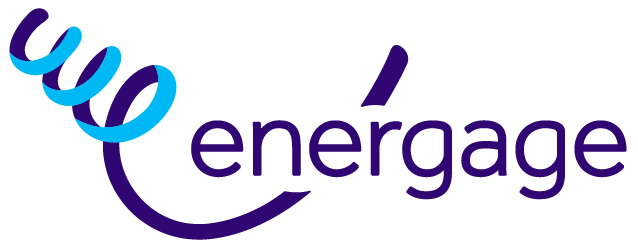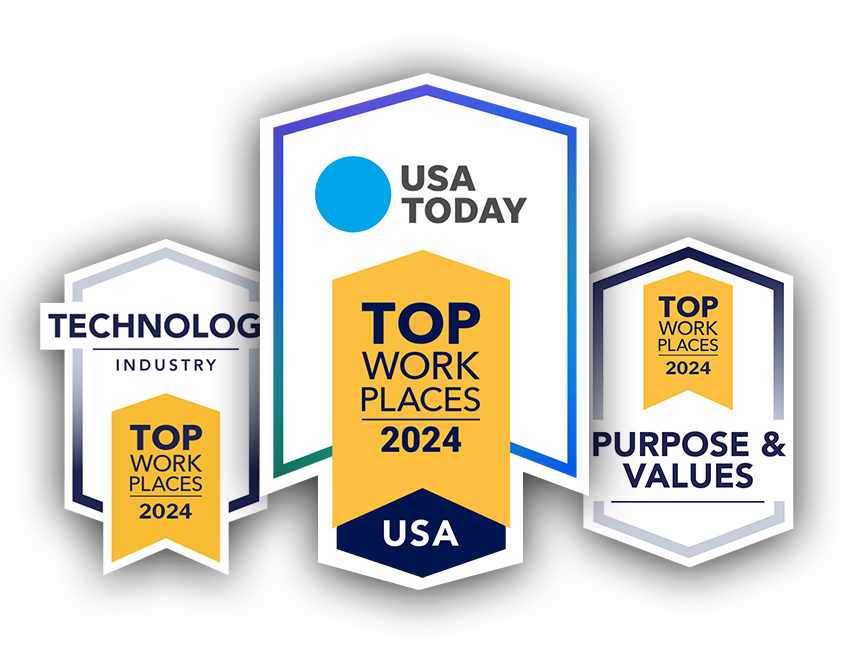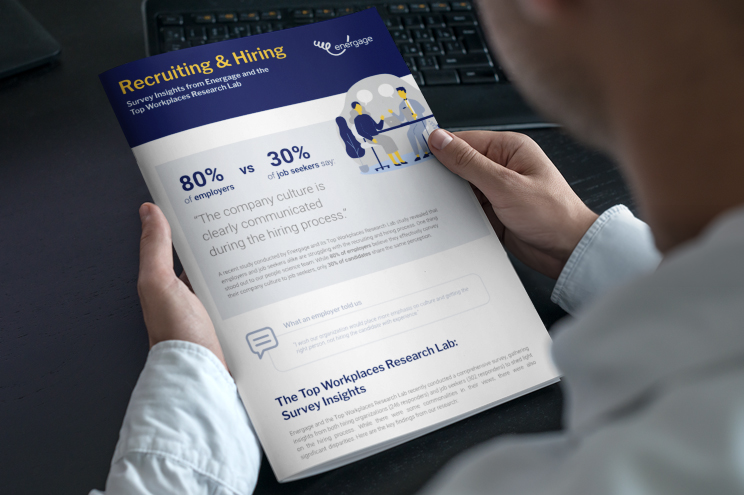In today’s competitive job market, employee well-being is no longer a “nice-to-have”; it’s a crucial factor in attracting and retaining top talent. Companies that prioritize the physical, mental, and emotional health of their workforce see happier employees and tangible benefits such as reduced sick days and increased productivity. When employees feel their well-being is valued, they are more engaged, motivated, and loyal to the organization.
But the significance of well-being extends beyond individual health — it reflects the company’s culture and values. A commitment to employee well-being signals to current and prospective employees that their organization genuinely cares about their overall quality of life.
Research by the Energage People Science Team shows a stark contrast between how well-being is perceived in Top Workplaces compared to other organizations, with significantly higher ratings among the former. This isn’t just a statistical observation; it’s a testament to the power of prioritizing people over profits.
Why employee well-being matters
Well-being is a priority for employees, so organizations should prioritize it, too. Those that foster employee well-being are better able to attract top talent and keep that talent for longer. That’s because employees are more likely to be motivated and engaged with their work when they know their organization cares about their well-being.
Prioritizing employee well-being is also an investment in employee health, with their physical, mental, and emotional health leading to secondary benefits of fewer sick days, lower healthcare costs, and higher productivity.
Discover More: A Guide to Employee Well-Being
Well-being at Top Workplaces vs. other organizations
Aspiring organizations are companies striving to become Top Workplaces. Those who compete generally have stronger-than-average cultures. While 64% of employees at aspiring organizations responded positively to the Well-Being statement on the Workplace Survey, the number jumps to 79-96% at Top Workplaces.
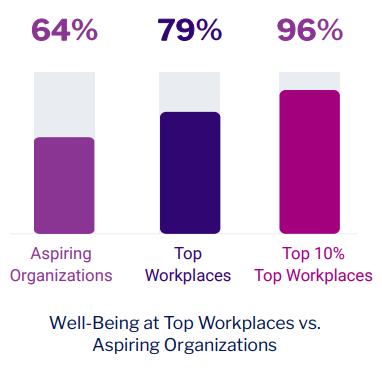
Insights on employee well-being
Several new statements have been added to the survey as part of Energage’s commitment to evolving the Workplace Survey to meet the changing needs and expectations of organizations and their employees. One of these new statements addresses employee well-being:
“This company does a great job of prioritizing employee well-being.”
Well-Being is an addition to the “Fairly Valued” Workplace Experience Theme. It measures a concept that is often considered table stakes in today’s employee experience. People-oriented organizations support their employees’ lives outside of work, ensuring they have what they need to care for themselves and their families. By assessing employee well-being, we provide a more holistic view of ensuring employees feel valued and have a strong foundation for a positive Workplace Experience.
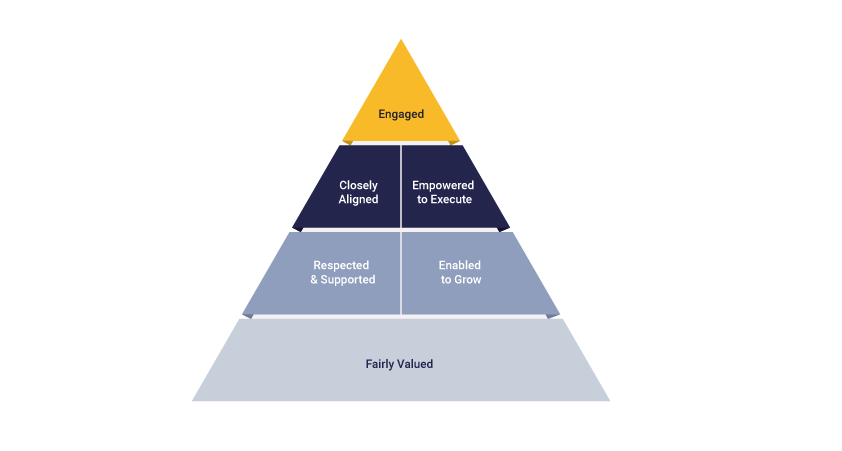 Since well-being was formally introduced as a research statement in the Fall of 2024, we have collected over 650,000 survey responses.
Since well-being was formally introduced as a research statement in the Fall of 2024, we have collected over 650,000 survey responses.
Employee well-being survey stats
- 76% of employees rated their organizations positively on this topic. This number increased to 79% for Top Workplaces and dropped to 64% for Aspiring organizations. Put another way, one-third of employees at Aspiring organizations believe employee well-being is not sufficiently prioritized, considerably more than at Top Workplaces.
- While 87% of senior managers believe their company prioritizes well-being, only 74% of team members agree. This suggests a disconnect between the perceptions of leaders and team members, which may cause leaders to underestimate issues with employee well-being.
- New hires are very positive about well-being, with 83% responding favorably. Following typical response patterns, middle-tenure employees scored lowest, 74% favorable for those working at their organizations for 3-10 years. In other words, about a quarter of middle-tenure employees feel well-being could be given more attention at their organization, perhaps due to a decline in work-life balance or increase in responsibilities over their time at the organization.
Highest scoring sectors:
- Advertising & Marketing (82%)
- Construction (81%)
- Services (81%)
Lowest-scoring sectors:
- Government (65%)
- Healthcare (67%)
- Education (67%)
Supporting employee well-being
Efforts to nurture a culture that values employee well-being are most successful when they come from multiple sources and levels across the organization. Here’s how people can help:
Leaders
As with many issues, leaders can shape the culture around well-being by prioritizing it, ensuring well-being initiatives and resources are funded, communicating the importance of well-being, and modeling it in their own lives. Leaders can also ensure that well-being is regularly measured and act on areas of concern.
Managers
Managers are best positioned to discuss individual circumstances with employees. They should check in on their well-being regularly, offering support, helping overcome challenges, and emphasizing the importance of work-life balance and well-being. They can also offer extra support and flexibility for employees struggling with work or personal issues.
Employees
Engaging in self-care, taking brief breaks at work, communicating their needs, and maintaining work-life boundaries can help employees manage their well-being at work. They can also offer support to struggling employees and advocate for changes to policies or practices detrimental to well-being.
Best practices for employee well-being
Getting started
Ease workloads
Ensure employees’ workloads are manageable in the short and long term by increasing staffing, more evenly distributing projects, or reducing taxing inefficiencies. Employees cannot effectively balance excessive workloads and their health for long, and one or both will suffer.
Foster connections
Remote and distributed workplaces have increased feelings of social isolation and loneliness among many employees. Provide opportunities for social connection and to build relationships, such as team-building activities, larger social events, messaging channels, and more.
Talk about it
If well-being is treated as an afterthought or never discussed, employees will unlikely see it as an organizational priority. Encourage leaders and managers to bring up well-being in their conversations and communications and to provide space to discuss well-being concerns and activities that foster well-being with their teams.
Manage busy seasons
Many organizations and industries have periods when work is higher than usual. While these are sometimes a necessary evil, organizations should ensure they do everything they can to help employees safeguard their health through planning and support before, during, and directly after the busy periods.
Big picture plans
Offer assistance via EAPs
Employee Assistance Programs (EAPs) are common benefits that provide support services for employees when they’re struggling. Consider providing EAPs and ensuring their benefits are regularly communicated to employees.
Consider flexible work arrangements
Remote or hybrid work and flexible work hours allow employees to manage their work and personal lives better, lowering stress and improving well-being in the process.
Drive wellness programs
Health and wellness programs can take many forms. Still, most strive to help employees live healthier lives, reduce stress, and improve overall well-being. These may include stress management, financial wellness, physical fitness, dietary guidance, and mental health support.
Don’t forget about pay & benefits
While employee well-being isn’t solely driven by compensation, it’s incredibly difficult to be healthy or feel your organization cares about your health if you can’t afford housing, food, healthcare, and other key expenses. Since stressed and unhealthy employees are unlikely to perform their best, investing in their compensation pays off in more ways than one.
Employee well-being: what to watch for
High-stress roles
Beyond workload, some roles and industries have higher than average rates of stress. Provide stress-management tools, adjust staffing, and implement other supportive practices to ensure these employees don’t burn out.
Safety concerns
Physical safety is fundamental to well-being and must be safeguarded by organizations. Ensure employees conduct their jobs safely and that employee safety is always prioritized over all other concerns, including meeting quotas, staffing issues, and more.
Lack of rest
Employees cannot maintain their health or perform at their best without time to rest. Ensure employees are given the time and ability to recover outside of work, including fully disconnecting, not being constantly on-call, and providing enough staffing to cover all regular work and for employees to take time off.
Frequent fire drills
Emergencies happen, and most employees will understand when they need to pitch in to help address them. But if the organization seems to have many emergencies, it’s time to reflect on what can be done to prevent them and cushion employees from their impact.
Toxic cultures
Organizations and teams may inadvertently foster cultures of hostility, bullying, discrimination, unnecessary competition, negativity, and more. Being surrounded by such toxicity is unhealthy for employees and usually leads to other negative outcomes for the organization.
How to measure employee well-being
For company leaders, understanding the state of employee well-being is not only essential but also a proactive step toward cultivating a thriving workplace. Implementing a third-party, confidential survey is a powerful way to gauge the current landscape of employee well-being within your organization. By doing so, you gain invaluable insights directly from your employees, allowing you to identify strengths and areas for improvement.
This data-driven approach enables you to create a tailored roadmap for enhancing well-being, focusing on what truly matters to your employees. Prioritizing well-being isn’t just good for your people — it’s a strategic investment in your organization’s overall success and sustainability.
Discover More: Creating an Employee Well-Being Strategy
Measure employee well-being today
Take the next step and measure employee well-being with the industry’s most trusted employee engagement survey. It’s also the same survey that powers the nation’s Top Workplaces program. See how your workplace measures up, uncover your culture strengths, and get data-driven insights for improvement.
